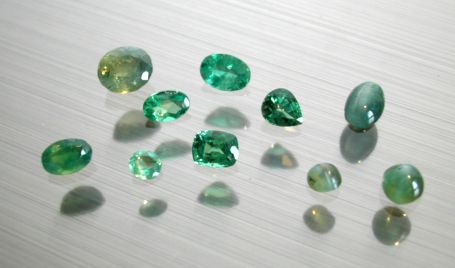 |
 |
| �V�R�̃A���N�T���h���C�g(Natural alexandrites) 0.11 - 0.98ct | �����A���N�T���h���C�g�iSynthetic alexandrites�j0.54 - 2.41ct |
�@
���ΐE�N���\�x�����iChrysoberyl�j
�@
3�D�A���N�T���h���C�g�iAlexandrite)
 |
 |
| �V�R�̃A���N�T���h���C�g(Natural alexandrites) 0.11 - 0.98ct | �����A���N�T���h���C�g�iSynthetic alexandrites�j0.54 - 2.41ct |
�@
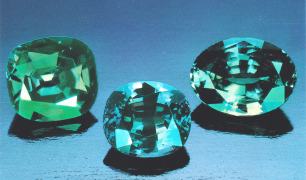 |
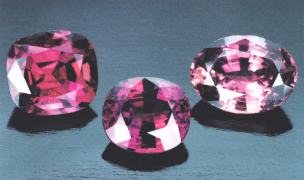 |
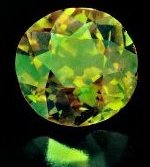 |
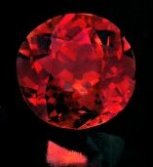 | ||||
| 1.29ct | 1.06ct | 1.32ct | 1.29ct | 1.06ct | 1.32ct | �@8.9ct�@Srilanka �A�����J���R�j������ American Museum of Natural History | |
| Ural
Mtn. Russia |
Hematita Minas Gerais, Brazil |
Ural
Mtn. Russia |
Hematita Minas Gerais, Brazil | ||||
�@
| �����n (Crystal System) |
���w�g�� (Composition) |
���[�X�d�x (Hardness) |
��d (Density) |
���ܗ� (Regractive Index) |
| �������n (Orthorhombic) |
Al2B2O4 | �W1/2 | �@3.70�|74�@ | 1.74�|76 |
�@�@�@
�@�A���N�T���h���C�g�͋��ΐi�N���\�x�����j��0.3�|0.5���̎_���N�����A1-1.6���̎_���S�A�����0.01-0.03���Ɣ��ʂ̎_�����@�W�E�����܂ޕώ�ł��B
�����̕s�����ɂ��A���z�����ł̓G�������h�̂悤�ȗ[�A���M�����ł̓��r�[�̂悤�Ȑԁ[�Ԏ��ɕϐF����]�ɂ��H�ȕ�Ƃ��Ĕ����������璿�d����Ă�����ł��B
�@��q����悤�Ƀ��V�A�̃E�����R���ɂ���G�������h�z�R�Ŕ�������A���̍c��A���N�T���h���U���Ɉ��݃A���N�T���h���Ɩ�������܂����B
�@
�@�A���N�T���h���C�g�͍z���W�{�ł���A��Ƃ��ăJ�b�g���ꂽ���[�X�ł���A�ł��l�C�̂����z���̕M���ɏグ������̂ł��B
�@���������̋��������ɂ߂ď��Ȃ��H�����̋H���ȍz���̕M���ɋ������܂��B
�@�Y�n�̓��V�A�̃E�����R���A�u���W���A�X�������J�A�W���o�u�G�A�^���U�j�A�A�}�_�K�X�J���A�C���h�Ɛ�����قǂł��B
�����������̎Y�n�������Ɉ��肵�č̂��킯�ł͂Ȃ��A�E�����R���ł͕���̎�����20���I���߂ɂ͌͊����Ă��܂��܂����B
�u���W���Ō��������G�}�`�[�^�̍z����1987�N��3�����ԂŌ@��s������܂����B�@�܂��X�������J�ł�1980�N�ȍ~�͎Y�o���������A�W���o�u�G������10�N�]�͍z�R�̉ғ��͒�~���ꂽ�܂܂ōĊJ�̌����݂͂���܂���B
�@20���I������21���I���߂ɂ����ă^���U�j�A�̃g�D���h�D���[�ƁA�}�_�K�X�J���̃C���J�J�ɂĂ�������L���ȉ\�������L��ȕY���z������������A�A���N�T���h���C�g������Ă��܂��B�@����ǂ����\��ނɋy�ԑ��l�ȕ�ɍ������ċH�ɃA���N�T���h���C�g��������Ƃ����킯�ł�����A���̐��ʂ͗]����҂ł��܂���B
�@���������āA���݈��肵������������̂̓u���W���e�n�̃y�O�}�^�C�g�z���A�^���U�j�A�̃}�j�����Εt�߂̃G�������h�z�R�ƃC���h��
�I���b�T�B�A�A�[���h���E�v���f�V���B�A�P�����B���A�ߔN�������ꂽ�y�O�}�^�C�g�z������Y�o����A���N�T���h���C�g�݂̂ł��B
�Ƃ����Ă��A�����ʂ͋ɂ߂ď��Ȃ��A1�J���b�g����傫�����������[�X�͑S���E�ŔN�ɐ��\�ɂ��Ȃ�Ȃ��ł��傤�B
�@
�@Alexandrite is a variety of chrysoberyl with impurity of 0.30-0.5wt.% Cr2O3, 1 - 1.6% wt.% Fe2O3 and 0.01 - 0.03 wt.% V2O3.
Because of these impurity, alexandite shows remarkable color change : emerald green to blueish green under daylight and red to redish purple under incandescent light.
�@Whatever, mineral specimen or faceted stone, alexandrite is certainly the gem minerals most seeked for. But is also the scarcest mineral among all. The supply soruce of alexandrite is quite limited ; Ural Mtns., Russia, Brazil, Zimbabwe, Srilanka, Tanzania, and Madagascar, and new sources from India.
These sources do not promise constant supply ; gem source of Ural Mtns. have almost exhausted in early 20th century, and rich veins disovered in 1987 at Hematita, Brazil was worked out only in three months, production from alluvial deposits of Srilanka has dramtically decreased since 1980's and mines of Zimbabwe were inactive for these 10 years. New alluvial deposits were reported from Tunduru, Tanzania and Ilakaka, Madagascar since end of 20th century but with sporadic productions.
�@So far, today, stable supplies are from pegmatites of Brazil, emerald mine of Tanzania, near Manyara Lake and new pegmatite deposits recently discovered in several states in India.
�@
���V�A�̃A���N�T���h���C�g (Russian Alexandrite)
�E�����R���^�R������̃A���N�T���h���C�g����
(Alexandrite crystals from Ural Mtns.)12x7cm
British Museum of Natural History�@50x20mm �@24x18mm 48x44x30mm�@�@
�@1830�N�̏t�A���V�A�c��A���N�T���h��II���̐��N���̓��ɁA���̌��ł͗ɁA���M���ł͐Ԃ�������z�����E�����R���̃^�R�����여��̃G�������h�z�R�Ŕ�������܂����B
���V�A���R�̐����̐F�ł�����A�ƐԂ̓�F�������V�z���͌�ɃA���N�T���h���Ɩ��t�����܂����B
�@�ڐG�ϐ���p�̍��_��Њ⒆�ɐ����������߂ɁA�����̑����͑��ʂ̕�L����T������Ύ��̂��̂͌����Ă��܂��B���������ɂ�20cm�ɂ��B����}�g���b�N�X�̒��ɒ��a��8cm���̓����Ȍ����������܂����B�N�����ܗL�ʂ��������߁A�J�b�g���ꂽ���[�X�̒��ɂ͖`���̎ʐ^�̂悤�Ɍ����ȐΐF����Ԏ��ւ̐F�ς����������i������A���̌㐢�E�e�n�Ŕ������ꂽ���Ɣ�ׂāA�ł��������A���N�T���h���C�g�̎Y�n�ł���܂����B��������Ύ��̃A���N�T���h���C�g�̎Y�o��20���I�����ɂ͓r�₦�Ă��܂��܂����B�@�j���[���[�N�̃e�B�t�@�j�[��ΓX�̃N���c���m���Q�O���I�����Ƀ��V�A��K��đ����ʂ���߂Ă������߁A���̍ɂ�20���I�����܂ł͎s��ɋ�������Ă��܂����B
�@�ɂ��s������̓E�����R���Y�̃A���N�T���h���C�g�͌��̕�ƂȂ��Ă��܂��܂����B���V�A������1990�N�ォ��́A�Ăэz���W�{���̌��������o���悤�ɂȂ�܂������A���Ă̂悤�ȕ���̌����͋H�ɐ̂̍z�R�̃Y�����甭�������݂̂ƌ����܂��B
�@An entirely new gemstone discovered in Tokovaya's mica schists had strange ability change color under prevailing light. In day light, rich green colors, while at night, under artificial light, it emitted red hues. Ostensibly found on April 23, 1830, the day young Czarevitch Alexander Nicolajevitich came of age, the new gem created a sensation. It was name "alexandrite" in honor of the yourth who would become Czar in 1855. To ensure even greater popularity, alexandrite's colors of red and grean were Russia's national military colors.
�@ Most of Russian alexandrite crystals are heavily included with fissures dute to metamorphic origin in phlogopite mica schist and few is facettable as gemstone. However, spectacular matrix of 20cm wide, including 8cm diameter crystals were recorderd. Thanks to high chromium contents, some facetted stones shows blue-green to redish purple color change to have been appreciated as the best alexandrite ever discovered. Such gem alexandrite crystals exhasuted in early 20th century.
Dr. Kunz of Tiffany visited Russia at that time cornered so considerable gemmy crystals that its's stock have been the major source of world's facetted alexandrite until middle of the century. After that, alexandrite have been considered as gemstone of a vision. since mid 1990, after Soviet regime decayed, specimens appeared in mineral market but magnificient gem alexandrites of legend were rarely discovered from ancient mine dumps.
�ʐ^�̌����͂���������M�����ł��F�ς�肷��悤�ɂ͌����܂��A�������`�F���V�[�E�t�B���^�[��ʂ��Č���ƑN�₩�ȐԂɔ��F���Ă��Ă��܂��B
�@�A���N�T���h���C�g�͒��̌��Ɣ��M���̌��ƂŐF�ς�肷�鎖���ő�̓����ł͂���܂����A���������̖{���̔������́A���̌��Ō���Ɠ��̋P�������ΐF�ł͂Ȃ����Ǝv���܂��B�G�������h�̗Ƃ��A�܂����ɂ�锭�F�̃p���C�o�̃g���}�����Ƃ��قȂ�A�Ɠ��̑u�₩�Ȑ݂�тт��ΐF�́A������蔒�M���ŐԂ̔��F���������Ȃ��Ƃ��\�ɖ��͂�����܂��B
�@Alexandrite crystals of the photo does not turn to redish color even under incandescent ligh but reacts to deep red through chelsea filtor. Although color change is considered as the most significant characteristic of alexandrite, fresh green color in daylight is far fascinating, rather than color change effects, that is too much talked about.
�@�@�X�������J�̃A���N�T���h���C�g (Alexandrite from Srilanka)
19.38ct ���M�����̐F
(Color under incandescent light)0.42ct�@5.8x4.1mm
�@���炭���V�A�Ŕ��������y���̂���Y�o���Ă����ɈႢ����܂���B�@�������Ȃ���A�X�������J�Y�̑唼�̃N���\�x�����ƃA���N�T���h���C�g�Ƃ͋��炭�S�ƃ`�^���Ƃ𑽂��܂ނ��߂ł��傤�A���̎ʐ^�̂悤�Ɋ��F��ттĂ��ă��V�A�Y�̂悤�ȗ���Ԏ��ւ̌����ȐF�ς��������܂���B
�@���̂��ߒ����ԃX�������J�ł̓N���\�x�����͓��������F�n�������g���}�����̈��ƍl�����Ă����悤�ŁA���̐F�ς���������������ڂ��W�߂邱�Ƃ͂���܂���ł����B�A�����J���R�j�����ق�8.9ct�̕W�{�������ȐF�ς��������܂����A���R�����̐F�͉��F�[���F��ттĂ��܂��B
�@�ŋߓ��肵��0.42ct�̕W�{�́A�������Ȃ���E������u���W���Y�̂悤�ɔ������G�������h�E�O���[���ł��B�@Srilanka is known as producer of chrysoberyl, cats'eye and alexandrite. Probably, considerable quantity of alexandrite might have been mined and sold erroneously mistaken as similar colored tourmaline, becuase most of Srilankan chrysoberyl and alexandrites are brownish color, due to high iron and titanium impurity.
�@19.38ct alexandrite is the typical example of Srilankan brownish specimen. A 8.9ct stone of American Museum of Natural History in New York too has yellow-brownish body color, despite notable color change.
�@Although small, 0.42ct cushion cut stone is a rare exception to have clean emerald color, like Ural and Brazilian alexandrite.
�@Recently, production of Srilankan alexandrite is said to have dropped considerably.
�C���h�̃A���N�T���h���C�g (Indian alexandrite)
1990�N��ɓ����ăC���h�̃I���b�T�A�P�����A�^�~�[���E�i�|�h�D�A�A�[���h���E�v���f�V���B���̊e�n�Ńy�O�}�^�C�g��z���̔������������A�N���\�x�����A�L���b�c�E�A�C�A�A���N�T���h���C�g������A2000�N�������Ύs��ɓo�ꂵ�n�߂܂����B
�@2�J���b�g�����̏����������̒Ⴂ���̂��唼�ł����A���ɂ͑N�₩�ȐF�ς�����������̂�����A�H���ȃA���N�T���h���C�g�̐V�Y�n�Ƃ��Ē��ڂ���܂��B���R�� ���M�� 0.42ct�@5.8x4.1mm
�@Since early 1990's, Pegmatite veins with varieties of gemstones, including crysoberyl, cat's eye and alexandrites have been reported from Orissa, Kelala, Tamir-Nadu. Andra Pradesh States, etc., Alexandrite began to apear in the market since early 2000. Although most of Indian alexandrites are small and with heavy inclusion, but some shows remarkable color change.
�@Since world's alexandrite production is quite limited, new Indian production is welcomed rom gem industry.
�u���W���̃A���N�T���h���C�g�iBrazilian Alexandrite�j
�@���M��(Incandescent light) �@���R��(Daylight)�@�@ ���M�� (Incandesent light) ���R�� ( Daylight ) 1.06ct 1.4cm ( 2 .6ct ) Keith Mychaluk Collection Hematita, Brazil
�G�}�`�[�^�̃A���N�T���h���C�g�iAlexandrite from Hematita Mine)
�@�@20���I�n�߂Ƀ��V�A�A�E�����R���̎������͊����Ĉȗ��A����ɕC�G����A���N�T���h���C�g�̎Y�o�͓r�₦�Ă��܂����B������1986�N���Ƀu���W���A�~�i�X�E�W�F���C�X�B�G�}�`�[�^�Ő��E�̕�ΊE��k��������V�Y�n�̔���������܂������A���̍z�����R�����Ō@��s�����ꂽ�^���͕ʓr�A��Γǖ{���g���̕�h�ɂďЉ�܂����B�@
�@�G�}�`�[�^�Y�̃A���N�T���h���C�g�����̓y�O�}�^�C�g�N���ŕ�L�������Ȃ������x�������̂������ł����B
����Ɏ_���N�����̊ܗL�ʂ�0.30 �`0.44wt.%�A�_���S��1.11�`1.59wt.%�A�_�����@�i�W�E����0.01�`0.03wt.%�A�ƃE�����Y�̍ŏ㋉�i�ɕC�G�������Z���s���N�A���Y�x���[�F�A�Z�����[�h���C�g�̐Ԃւ̐F�ς��������܂����B
�@3�����ԂŌ@��o���ꂽ���\kg�̌����̂���10kg�̏㋉�i��30�`45%�̍����䗦�ŗ��z�I�ȐF�ς����������O���̃A���N�T���h���C�g�̎Y�o�ł���܂����B
�@
�@Since Russian alexandrite mine in Ural Mtns. exhausted in early 20th century, there have been no gem alexandrite production, equivalent to Russian quality. And in end of 1986 at Hematita, Minas Gerais, Brazil, there was a striking discovery of new alexandrite mine, which detailes are written in Gem-Episode
"Alexandrite Mythology" .
�@
�@Hematita alexandrite renowned for clean and high transparency thanks to pegmatite origin. The Hematita alexandrites contain 0.30-0.44wt.% Cr2O3, 1.11-1.59wt.% Fe2O3, and 0.01-0.03wt.% V2O3. The best Hematita gems compare very favorably with the best Russian material: greenish blue to blue in sunlight and strong pink,raspberry, or deep rhodolite or ruby red in incandescent light. About 30% to 45% of the best 10kg, among several tens of kilograms of crystals recove
+red in three months exhibited this color change.
0.98ct 6.2x5.2mm 0.30ct 5.1x3.4mm 0.56ct �@�@0.25ct
(4.8mm) �@(3.5mm)15x11x8mm 2.2g 0.47ct 5.4x3.8mm 0.11ct Ø3mm Hematita, Minas Gerais, Brazil �@�A���N�T���h���C�g�͕�ɋ���������n�߂�������ł��S�̂����ł������A�����Ԍ��邱�Ƃ�������Ȃ���������̉Ԃł���܂����B
�@�R���N�V�������n�߂Ă�����A�����W�{�������肵�����̂́A�Ⴆ�c�[�\���̕�V���[�ł������ǎ��̃��[�X���������邱�Ƃ͋H�A���Ɍ����ȃ��[�X�ɑ��������Ƃ���œ���肪�o��l�Ȑ����ł͂Ȃ��A�܂��Ɍ��̕�ł���܂����B
�@��Ύ��̃A���N�T���h���C�g�͖{���Y�o���ɒ[�ɏ��Ȃ���ɋ��炭�͐��E�̎Y�o��80���ȏオ���{�̍�������i�s��ɋz������Ă��܂��B
�@�ŏ�̃A���N�T���h���C�g�ł���J���b�g������1��5000�h���ɂ��Ȃ�܂����A���ꂪ����i�ƂȂ�Ɣ��l��500���~�ƂȂ��Ă��s�v�c�͂���܂���B
�@���������Ĕ��������[�X�͂��ׂĕ���i�Ƃ��Ďg���邽�߁A���[�X���s��ɏo���@��͂Ȃ��Ȃ�����܂���B
�@����Ȏ���ŁA�Ƃ�����R���N�V�����Ƃ��Ď�ɓ��ꂽ���[�X�͎ʐ^�̂悤�ɂ܂��Ƃɕn��Ȃ��̂���ł����B
�@0.11�J���b�g�̏����ȃ��[�X��1988�N�ɃT���p�E���̃��v�u���J�����̓��j�s�Ńg���}�����Ƃ��Ĕ����Ă��܂����B
�ꌩ���ăA���N�T���h���C�g�ƕ�����܂����������̓g���}�����Ɍ��܂��Ă���ƓۋC�Ȃ��̂ŁA������1�h���̌@��o�����ł����B
�@5�N��Ƀh�C�c�̃C�_�[�E�I�[�o�[�V���^�C���Ō������̂�0.3�J���b�g�̃��[�X�B
�J���b�g������ 500 �}���N�ł�����1�� 150�}���N �i1���~���x�j�ƕi���̊��ɂ͊i���ł����B
�@���������̑傫���ƕi���őÓ��Ȓl�i�̃A���N�T���h���C�g�̃��[�X���Ύ��̌�������肷�邱�Ƃ͑�ϓ���̂�����ł��B�@Although alexandrite has been a target of my interest since very beginning of my gem collection, it was an unfinished dream, even just to see a quality alexandrite in the market, due to extreme rarity. And a few occasion I could see them, prices were far beyond the budget of amateru collector. My collection I could afford to get are small pieces of speciment classes ; a 0.11ct stone sold as tourmaline for just as US$1.00 at Sunday market of Sao Paulo, Brazil or, 0.30ct small but clean stone, I bought at Idar-Oberstein , Germany for a super bargainprice of DM500/ct. and other specimen class stones. It would be almost impossible to encounter facetted stones or gem alexandrite crystals with reasonable quality and size for reasonable price.
2.16ct 10x6mm
�@�@���R��(Daylight)�@�@�@�@���M��(Incandescent light)
���炭�u���W���E�G�}�`�[�^�Y
Probably Hematita, Brazil���̑��̃u���W���̃A���N�T���h���C�g�iOther Brazilian alexandrite�j
�@���̃A���N�T���h���C�g�͕�e�������Ȃ���ϓ����x�̍����A�����Ď��R���ł̔Z���u�₩�ȗΐF����ۂɎc��܂��B
���M�����ł̐F�ς�肪���W�����ߍŏ㋉�ł͂���܂��A����������������x�������A2�J���b�g���z����傫�Ȃ��̂͑�ϋH�ł��B
�@�G�}�`�[�^�ł̔����܂Ńu���W���ł͋H�Ƀo�C�A�B�ƃG�X�s���g�E�T���g�B�A�����ă~�i�X�E�W�F���C�X�B�̃T���^�i�E�A�����J�[�i�여�悩��A���N�T���h���C�g���H�ɔ�������邱�Ƃ�����܂����B�@���������V�A�Y�قǂ̌��I�ȐF�ς�����������̂ł͂Ȃ��A�W���D�ΐF����s���N�ɂȂ���x�̒�i���̂��̂ł����B
�@1975�N�ɂ悤�₭�e�I�t�B�[���E�I�g�[�j�ɋ߂��}���J�`�F�[�^�̒��̖k�̃R���S�E�h�E�t�H�S��̃y�O�}�^�C�g���̕Y���z���ɂăA���N�T���h���C�g����������܂����B1980�`1982�N�̃s�[�N���ɂ�4000�`5000�l�̍z�v���̌@�ɏ]�����ē�����Ă��܂����B�����ȗ�1985�N�܂ł�10�N�Ԃ�2kg�̓����ȏ㋉�i�̌�����6�`8kg���̎��̈����A���N�T���h���C�g���̂�܂����B�������㋉�i�ɂ��Ă��A���F������������W���s���N�ւ̐F�ς��ŁA���������͂����Ə������A��ɔ������ꂽ�G�}�`�[�^�Y�Ɣ�ׂ�Ɨy���Ɏ�����������̂ł����B
�@���̑��u���W���ł̓~�i�X�E�W�F���C�X�B�C�^�r���A�S�C�A�X�B�̃J���i�C�[�o���A�ϐ��z���N���̃G�������h�z�R�̉_��Њ⒆����H�ɃA���N�T���h���C�g����������邱�Ƃ�����܂��B�@����̓E�����R���A�^�R������A�^���U�j�A�̃}�j�����A�W���o�u�G�̃t�H�[�g�E���B�N�g���A�A��A�t���J�̃g�����X���@�[���Ɠ����N���ł��B�@���������ĕ�Ύ��͑�ϋH�ł��B
�@Until Hematita discovery, alexandrite has been recorded in Bahia, Espirito Santo and Santana-Americana River of Minas Gerais, but poor quality one only. In 1975, at alluvial deposit of pegmatite origin of Corego do Fogo River, north of Malacacheta, near Teofilo Otoni, there was and significant alexandrite discovery. During 1980-1982, maximum 4000-5000 galinpeiros were working. During 10 years from 1975 to 1985, 2 kg of transparent and 6-8kg of low quality crystals were recovered. But even better quality stone showed yellowish green to palen pink color change and stones were far smaller than that of Hematita one. Other alexandrite localities are from emerald mines of metamorphic origin, in mica schist of Itabila, Minas Gerais and Carnaiba, Goias. These alexandrites are similar origin as Ural Mtns., Tokowaya River, Manyara Lake, Tanzania, fort Victoria, Zimbabwe and Transvaal, South Africa, and gem quality crystals are rare. �A�t���J�̃A���N�T���h���C�g(African Alexandrite)
�^���U�j�A�̃A���N�T���h���C�g(Tanzanian alexandrite)
7.19ct 0.39ct�@4.8x4.0mm 51.81ct Tunduru Lake Manyara
�@ �^���U�j�A�ł̓}�j�����Εt�߂̃G�������h�z�R����N���\�x�����Ƌ��ɃN�������܂ޕώ�̃A���N�T���h���C�g�̎Y�o���m���Ă��܂��B�ʂ͏��Ȃ��̂ł������z����u�����ł̐��甒�M�����̐Ԏ��ւƌ����ȐF�ς��������܂��B
�@���V�A�Y��u���W���Y�̂��Ă̍ŏ㋉�i�Ɣ�ׂ�ƐF���������W���̂ł����A�����x���������������̂ł��B���炭���ݓ���ł���ł��������A���N�T���h���C�ƌ�����ł��傤�B1990�N��ɂ͐��E�e�n�̕�V���[�ɂQ�C�R�̋Ǝ҂��o�i���Ă��܂������A�����̓J���b�g������3000�h���Ƃ��Ȃ�̍��l�ł܂��ɍ���̉ԁB����ł��Ȃ��܂܂ɂ��̌�s�ꂩ��p�������A2010�N������1�J���b�g�����̏����Ȃ��̂ł����A�J���b�g���萔�S�h���Ɣ�r�I�Ɏ荠�Ȑ����łۂۂƍēo�ꂵ�Ă��܂����B
�@1995�N���ɔ������ꂽ�g�D���h�D���[�여��̕Y���z��������A���N�T���h���C�g������Ă��܂����A�ʐ^���������ł̓E�����R����u���W���̍ŏ�i�Ɣ�ׂđ��F�̂Ȃ��i���ł��B
�@
�@Emerald mine near Manyara Lake, Tanzania is known to produce alexandrite and chrysoberyl. Although production is limited (probably less than 1000ct/year) and color is less saturated compared with best quality Russian and Brazilian alexandrite, there are clean stones which show significant color change from bluish green in daylight to redish-purple under incandescent light. Probably Tanzanian alexandrite is one of the best one, available in the market, today.
�@Alluvial deposits, discovered in 1995 along Tunduru River produces excellent alexandrite as shown in the photo.
�W���o�u�G�̃A���N�T���h���C�g (Alexandrite of Zimbabwe)
54.2ct�@21x17mm
�@�A�t���J�̃W���o�u�G�ł͂�͂�G�������h�z�R���炩�ăA���N�T���h���C�g����������܂����B�ʐ^���番����悤�ɂ��Ȃ���������̂ŁA�H�ɕ���̂��̂��������Ǝv���܂��B�@�c�O�Ȃ��猻�݂ł͐����I�A�Љ�I�ȍ����̂��߂ɍ̌@�����͒�~�����܂܂ɂȂ��Ă��܂��B�s��ɂ͎����ܕW�{���̌������p�������܂����A�J�b�g���ꂽ�A���N�T���h���C�g�͎������A�ʐ^�������������Ƃ�����܂���B
�@Emerald mines of Zimbabwe produced alexandrite. Some crystals seemes to be facetable. However, mining activities have long been ceased because of political instability. Although crystal specimen rarely apears in the market, faceted alexandrite never exist.
�}�_�K�X�J���̃A���N�T���h���C�g(Alexandrite of Madagascar)�@
6ct
�@�}�_�K�X�J���ɐ��S����y�O�}�^�C�g�n�т̒��ɂ͔������N���\�x���������̎Y�n�������āA�H�Ɍ����W�{���̃A���N�T���h���C�g�͕���Ă��܂����B20���I���ɔ������ꂽ�C���J�J�̋���ȃy�O�}�^�C�g���̕Y���z���̓X�������J�A�u���W���A�^���U�j�A�̃g�D���h�D���[�Ǝ��A�ʂƂ��ɕ��Ԑ��E���w�̕�z���ł��邱�Ƃ͊m���ł����A�A���N�T���h���C�g����������A2000�N������s��Ɏp��������悤�ɂȂ�܂����B�ʐ^�̃��[�X�̐F���������܂�N���ł͂Ȃ��悤�Ɍ����܂����A�A���N�T���h���C�g�͎ʐ^�ł͖{���̐F�̍Č�������ȕ�ł��̂ŁA���ꂾ���ł͉��Ƃ��i���]�X��f��ł��܂���B�����ȐF�ς��ƍ��������x�ƂU�J���b�g�Ƃ����傫�����炷��ƁA��ϗL�]�ȎY�n�ł��邱�Ƃ͊ԈႢ����܂���B�@
�@Several hundreds of pegmatites of Madagascar is renowned for beautiful chrysoberyl crytals and rarely specimen class alexandrite has been reported. Huge alluvial deposits of pegmatite origin, discovered at Ilakaka at end of 20th century is considered as equivalent one as that of Tunduru, Tanzania, Srilanka, Srilanka and Brazil. Transparent and big alexandrite crystals were reported and facetted stones began to appear in the market recently.�@
�����A���N�T���h���C�g (Synthetic Alexandrites)
�@�@�N���\�x������19���I���ߍ�����t�����X�̉Ȋw�҂����ɂ���ăt���b�N�X�@�ɂ�鍇�����������݂��܂����B�������Ȃ��瓖���̋Z�p�ł͐����ȉ��x�R���g���[�����o���܂���ł�������A���p�ƂȂ�傫�Ȍ����̐����ɂ͎���܂���ł����B
�@1960�N�㏉�߂ɂȂ��Ă悤�₭�n�܂̌�������ȉ��x�����ɂ��N���\�x�����ƃA���N�T���h���C�g���������p������n�߂܂����B�@1965�N���A�x�����������t���b�N�X�@�ŁA1975�N�ɂ� Allied�@Signal �Ђ��`���N�����X�L�[�@�ł̍������s���܂����B
�@���̑�1970�N��ɂ͔M���@�ŁA�܂��t���[�e�B���O�E�]�[���@�A�K�X�ő̔����@�A�Ή��n�Z�@���X�A����Ƃ����鍇���@�����E�e�n�̌������A��w�A��Ɠ��Ŏ��݂��Ă��܂��B
�@�A���N�T���h���C�g�͂��̑��F���ɂ��ϔg�����[�U�[���U�p�̑f�q�Ƃ��ĊJ������܂����B���̋Z�p�͌R���A�ʐM���A�l�X�ȕ���Ŏg���Ă��܂����A��ʓI�Ȃ��͔̂畆�Ȃ��{����݁A�E�т̎��ÂȂǂɎg���Ă��܂��B�g����ς��邱�ƂŃ��[�U�[�̔畆�ւ̐Z���[�x���ς��̂ōL�͂Ȏ��Â��\�ɂȂ邽�߂ł��B
�@Since beginning of 19th century, French scientists started the experimental synthesis of crysoberyl by flux method, in vain. In those days, it was impossible to maintain accurate temperature control during crystal growth for three to six months. It was in early 1960, that developments flux materials study and accurate temperature control enabled the synthesis of crysoberyl. Ca.1965, Bell Laboratory synthesized alexandrite by flux method and in 1975, Allied Signal by Czochralski method. Since early 1970, various synthesis method ; hydrothermal, floating zone, gas-solid reaction, flame fusion etc., have been extended by numerous laboratories in the world. Color change characteristic of alexandrite (chrome doped crysoberyl) is an ideal device forf multi frequency lasor oscillator. Today the most popular utility of alxandrite lasor is for birthmark treatment thanks to its wider depth application capability.
�@
�A�����J�̍����A���N�T���h���C�g(Synthetic alexandrites of U.S.A.)
���R���iDaylight�j ���M���iIncandesent light�j ���M���iIncandescent light�j ���R���iDaylight�j 0.63ct 1.12ct
6.1x4.0mm 7.1x5.1mm3.63���� �@1.14ct �P�D46ct�@Ø6.6mm �@Creative Crystal�@�@�@�@�@�@�@�@ �@�@�@�@�@Nicholas�@
Litton airtron
1.26ctXL
0.70ct 6x4mm
�@��Ηp�̍����A���N�T���h���C�g���n�߂ēo�ꂵ���̂�1972�N�A�A�����J�E�J���t�H���j�A�B�ASan�@Ramon�ɂ���Creative�@Crystal�Ђ��t���b�N�X�@�ɂĐ����������̂ł��B
�N���G�C�e�B���E�N���X�^���Ђ�1985�N�ɐ����𒆎~���܂������ARamaura �������r�[�Ŗ�����J.O.�N���X�^���Ђ�90�N�㏉���܂ōɂ�̔����Ă��܂����B���̌�90�N��Ɂ@Litton�@Airtron �Ђ��`���N�����X�L�[�@�ɂ�鍇���A���N�T���h���C�g�� �hAlexite" �̖��Ŕ������܂����B
�@J.O.�N���X�^���Ђ͓������Ƀ`���N�����X�L�[�@�ł̍����A���N�T���h���C�g�������Ă��܂����BJ.O.�N���X�^���Ђ͎��g�ł̓A���N�T���h���C�g�̍��������Ă��܂���A���炭 Litton�@Airtron �А��� �hNicholas�@Created�@Alexandrite�h �u�����h�Ŕ������Ă���̂ł͂Ȃ����Ǝv���܂��B
�@���l�ɐ��E�e�n�̐��Y�҂��狟������AGEE,XL���A�Ǝ��̃u�����h�̃A���N�T���h���C�g����ɃA�����J�s��␢�E�e�n�̕�t�F�A�Ō��������܂��B
�@
�@The first synthetic alexandrite for gem use was made by Creative Crystal, Ramona, California in 1975 by flux method. The production was ceased by 1985 but J.O. Crystal, famous for synthetic "Ramaura Ruby" continued the sale of stock until early 1990. In 1990's, Litton airtron started the production of alexandrite made by Czochralski method, which was probably the same as "Nicholas Created Alexandrite" sold through J.O. Crystal, who themselved have never synthesized alexandrite. Synthetic alexandrites are relatively popular, particulary in U.S. gem and jewelery market under AGEE, XL, etc. brands. ���V�A�̍����A���N�T���h���C�g(Russian synthetic alexandrite)
1.81ct 12.1x6.1mm�@�@2.41ct 8.1x6.2mm
Novosibirsk, Russia0.53 - 0.98ct(7.1x5.1mm)
Thai-Russia27.3g 25.5g 27.3g 30x17x10mm �t���b�N�X�@�A���N�T���h���C�g
(Flux type alexandrite)�`���N�����X�L�[�@�A���N�T���h���C�g
(Czochralski pulled alexandrite)����(crystals) 1.54 �`16ct
�@�@���[�X(faceted stone) 1.07ct���R�� ���M�� �@���V�A�ł��m���H�V�r���X�N�ɂ���Ȋw�A�J�f�~�[�̒n�������������ɂē����`���N�����X�L�[�@�ł̍����ɐ������A��ɕ�Ηp�Ƃ��ăA�����J��h�C�c�s������ɂ��Ȃ�̗ʂ��o�ׂ���܂����B���������݂ł̓��V�A�̍����A���N�T���h���C�g�̓t���b�N�X�@�ɂ�鍇�����嗬�ɂȂ��Ă��āA���V�A�e�n�ƃ^�C�̍��ى��Tairus�ЂƂŐ������Ă��܂��B�@
�@���̏o�חʂ̓L���O�����P�ʂŏo�ׂ������ŁA���E�̍����A���N�T���h���C�g�͎�Ƀ��V�A����v�ȋ����҂ł����B
�@�@In Soviet Russia, alexandrite was first synthesized at Earth Science Acadmy at Novosibirsk, Siberia and considerable volume has been exported to the world for gem use. Todya production is conducted mainly by flux method and several laboratories and joint venture with Thai capital, "Tairus". The Russian synthetic alexandrites now dominate world market with severals kilograms of lot production.���{�̍����A���N�T���h���C�g (Japanese synthetic alexandrite)
���Z���̃`���N�����X�L�[�@�����A���N�T���h���C�g
Kyocera Czochralski synthetic alexandrite�@1.02ct 8.1x4.0mm ���R��(Daylight) ���M��(Incandesent light) �@
�@���{�ł�1976�N�ɋ��s�Z���~�b�N�Ёi���݂͋��Z���Ёj���`���N�����X�L�[�@�ł̍����ɐ������A�B�ꍑ���O�Ŕ̔������Ă��܂��B�@1980�N�����ɂ̓Z�C�R�[�Ђ��t���[�e�B���O�E�]�[���i�ԊO���W�����M���V�ш�@�Ƃ��Ă�܂��B����͌������ł߂��_���n���Q�������v���̌����̌��ˋ��ŏW�������ėn�����������Ɛ����܂��͐����Ɉړ����č����x�̒P����������������@�ŁA�����̐����Z�p���Ɏg���܂��j�ɂ�鍇���A���N�T���h���C�g�����i�����A�h�r�W�����[�u �F �t�����X��� �gBijou au rêve�i�r�W���[�E�I�E���[���j�F���̕�h �u�����h�ɂāA�����������̃G�������h��X�^�[�E���r�[���Ƌ��ɁA���炭100%�A�����J�s��Ŕ̔����Ă��܂��B�@
�@�����̍�����͐��X�̍��������̌����Ŗ������R����w�H�w���ŊJ�����ꂽ�Z�p���̗p���Ă���Ǝv���܂��B�@
��Ηp�r�̑��Ɏ�ɎY�Ɨp�ɏZ�F�d�H�A�Z�F�Z�����g���X�A�������̊�ƂŃA���N�T���h���C�g�̍�����90�N�㖖�ɂ����čs���Ă��܂����B
�@����i�p�ɐ��Y���Ă���̂͋��Z���݂̂ł��B���̊�ƁA��w�A�������͑S�ĎY�Ɨp�r�̌����A�J���A���Y�ł��B
�@���������݂ł͐V�����Z�p��f�q���J������A�����A���N�T���h���C�g�̐��Y�͖w�Ǎs���Ă͂��܂���B
�@In 1976, Kyocera has succeeded the alexandrite synthesis by Czochralski method and continues the production and sales for jelwelery under "Kyocera" and "Inamori" or "Crescenvert" brands. In 1980, Seiko has succeeded the alexandrite synthesis by floating zone method and commercialized under "Bijou au rêve" brand for jelwelery. Alexandite for industrial purpose are studied and synthesized by many enterprises and universities, such as Sumitomo group etc.
�@However, because of the apparition of new devices, alexandrite is no more manufactured.
�@
�����A���N�T���h���C�g�̒l�i (Synthetic alexandrite market prices)�@�����A���N�T���h���C�g�̓C���N���[�W�����̒��x�ȂǕi���ɂ��A���Ă̓J���b�g����150�`300�h���ƁA���̃G�������h��r�[���̍�����Ɠ��������ł����B
�@����͍����Z�p�̓�Փx��A�����܂蓙�����R�X�g�ɂ��l�t���ł͂Ȃ��A�P���ɐ��E�̍�����̃��[�_�[�ł���`���U���Ђ̃G�������h�ɏ��������̂ł����B�@
�@�������Ȃ���\�A�̕���Ƌ��Ƀ��V�A�Y�̍����G�������h�Ɠ��l�ɐ��Y�ߏ�ƋK�i�O�i�̔×��ɂ��_���s���O�������A���N�T���h���C�g�ł��N�����Ă���悤�ł��B���݂ł̓��V�A�E�^�C�Ő��Y���ꂽ���̂���x�ɃL���P�ʂŎs��ɋ��������قǂŁA���[�X�̒l�i�̓J���b�g50�h�����x�ɉ������Ă��܂��B
�@Prices of synthetic gems have long been US$150 to 300, whatever emralds, ruby, spphire, or alexandrite, or whatver, their production costs and it's difficulties and production yields. Pricing rule was totaly dominated by synthetic gem giant "Chatham" and all manufacturer followed, so-called "Chatham standard". However, since Soviet Russia collapsed in 1991, over produced emeralds and alexandrite by Russian garage manufacturers flooded the world market to cause hyper damping in the synthetic gem business.
�����A���N�T���h���C�g�̓V�R�Ƃ̎��ʂɂ���
(How to separate synthetic alexandite from natural one ?)�@
�����i���̂̓t���b�N�X�@�ƈ����グ�@�Ƃ��킸�V�R�ƑS�����������������A����ł͂������A��d�A���ܗ��Ƃ������A�ÓT�I�ȑ���ł̎��ʂ͕s�\�ł��B�@
�@��������Ȑ���C�A�A�����Г��̕�L�����F�߂�������Ɣ��f�ł��܂����A�������܂܂Ȃ��N���[���Ȍ������w�ǂł��B
���������āA�V�R�̍ŏ㋉�i�Ƃ̎��ʂ͓d�q���E�}�C�N���v���[�u��FTIR�i�t�[���G�ϊ��ԊO���z�������j�ȂǁA�������ɂ����|����ȑ���@�Ő��Ƃ����ׂȂ����莯�ʂł��܂���B
�@�����A���N�T���h���C�g�̍����ƓV�R�Ƃ̎��ʂ͑�ύ���Ȃ̂ł��B
�@ Alexandrites are now being synthesized in many countries under various method. As in case of other synthetic gems, they exactly same as natural counterpart, from point of physical characteritics, such as density and reflactive index, etc. Experts might identify them, for inclusions and growth characteristics or using sophisticated laboratory equipments for clean crystals. But in general, it is not easy to identify the synthetic alexandrite from natural one.
�@
�A���N�T���h���C�g�̃C�~�e�[�V�����iAlexandrite simulants�j
�@
���@�i�W�E���Y���̍����X�s�l��
(Vadium doped spinel)���@�i�W�E���Y�������T�t�@�C�A
(Vanadium doped sapphire)���[�U�[�K���X�@�iLaser Glass�j3.24ct 10.8mm 1.24ct 8x6mm 27.45ct 18.0x16.8x9.5mm ���R���iDaylight�j ���M��
(Incsandescent light)
�u�����Ƌ������M���Ǝ˂ŐF�ς���������A���L�T���h���C�g(Synthetic)�Ə̂���䕨�@���͍����X�s�l���@3.53ct 12.1x8.1mm
8.8ct�A�e�_�C�������h�iLab created�j F VVS1�A �������@18K White Gold Plated(�x�[�X�V���o�[925�j�̕\�����S�ăf�^����
�@��ϋH���ȐF�ς���������A���N�T���h���C�g�ƂȂ�A���̃C�~�e�[�V���������o����͓̂��R���Ƃł��B �@�@�@�@
�@�Ƃ�킯���{�ł�1960�N���̑�ϑ�����������A���N�T���h���C�g�Ə̂������s��ɏo����Ă��܂����B
�@���Ԃ��Ȃ����A��Ȃǂ͖��̂܂����̎���ɃA���N�T���h���C�g����ʂɏo���Ƃ͊�ł����C���͑S�Ă������T�t�@�C�A���X�s�l���Ɏ_�����@�i�W�E����Y�������C�~�e�[�V�����ł����B
�@�A���N�T���h���C�g�Ɍ��炸�A�����̎��v�X�������Ă�����̑S�Ă͉Ή��n�Z�@�ɂ�鍇���̃X�s�l�����R�����_���ɔ��F�܂����������r�[�A�G�������h�A�T�t�@�C�A�A�g�p�[�Y���X�ł����B �����̍����i�͍��ł����������R�̒l�i�ł����A�����͐���~�ƁA�T�����[�}���̂Ђƌ����̋����ɂ����������ύ����Ȃ��̂ł����B
�@ ���@�i�W�E����Y�����������T�t�@�C�A��X�s�l���́A���R���ł͐Ԏ��[���ł����A�������M���ł͔Z���s���N�ɔ��F���܂��B
����͐F�ς��ł͂Ȃ��������Ō��̐F���������ꂽ�����Ȃ̂ł����A �������A�f�l�ڂɂ̓A���N�T���h���C�g�̂悤�Ɍ����܂��B
�@�ŋ߁A�����A���N�T���h���C�g�Ə̂��郋�[�X�����i���l�b�g�s��ɕp�ɂɎp�������܂��B�ʐ^��27.45ct�̃��[�X�̓��V�A�̃`���N�����X�L�[�@���x��䕨�B
�@����Ɂ@8.8�J���b�g�i�����ł�3.5�J���b�g�j�̃l�b�N���X���A���L�T���h���C�g �isynthetic�@�F�ǂ߂Ȃ��قǂ̏������j �ƕ\������A�u���W���Y�̃A���N�T���h���C�g�̐F�ς��ʐ^�L���āA�V�R�ɂ͋ɂ߂ċH�Ȑ̍ŏ�i�ɕC�G����i�A�Ƃ�搂�����ł����A���͏d�����\���̔����ȉ������Ȃ������X�s�l���A�e�̓K���X�A ���������ܘ_��ł͂Ȃ��������ƁA���������䕨�Ȃ̂ł��B
�@�₢�����ƁA�d����̕\����]�L���������A�{���͋H���i���ƊJ������m�M�Ƃł��B��������J���b�g������100�~�ȉ��̒l�i�ł�����A ���Ⴂ�����Ƃ���Ŏ��Q�͂���܂���A���A�����܂ʼnR���S����ח��Ă邩�Ǝv���قǂ̐����̈����ł��B
�@�{���̍����A���N�T���h���C�g�͌��݂ł̓L���[�Z�����ׁX�Ƒ����Ă���̂݁A ���̑��̓��V�A���܂߂ĉ����̂ɐ��Y���~�ɂȂ��Ă��܂��B�]���āA���[�X�ł���A����i�ł���A�����̃L���[�Z�����i�ȊO�̍����A���N�T���h���C�g�Ə̂���i�́A�S�č����̃X�s�l�����R�����_���A ���邢�̓K���X���̊䕨�Ǝv���ĊԈႢ����܂���B
�@It is no wonder that imitations of such rare stone, like alexandrite apears.
A half century ago, synthetic sapphires and spinels doped with vanadium oxide flooded into the market as alexandrite. Although they did not show color change like genuine alexandrite, they looked pretty pink to reddish purple, under strong incandescent light, likely enough to cheat consumers.
�l�I�W�E���Y���̃��[�U�[�E�K���X�@�iNeodiumu doped laser glass)
�@��̉E���̎ʐ^�̓��[�U�[���U�p�Ƀl�I�W�E����Y�������K���X�ł��B���͎��R���ŗɁA�E�͔��M���ŐԎ��ɂƁA�S���A���N�T���h���C�g�Ɠ����F�ς��������܂��B
�@�����ȃA���N�T���h���C�g�̑���ɉϔg���̃��[�U�[�p�̑f�q�Ƃ��ĊJ�����ꂽ�l�I�W�E���Y���̃K���X�ł����瓯���F�ς���������̂����R�ł��B���̃��[�X�͂��ă~�����w���E�V���[�� �h�A���N�T���h���I���h �̖��� 1�� �W�}���N�Ŕ����Ă������̂ł��B
�@There are neodium doped glasses, developed as an replacemnt of alexandrite for variable frequency laser. As shown in photos, faceted laser glass called "Alexandrion" shows exactly same color change as alexandrite. Fortunately, it would be easy to separate laser glass from alexandrite, because of extreme transparency and cleaness, as a nature of carefully manufactured glass for laser purpose.
�@